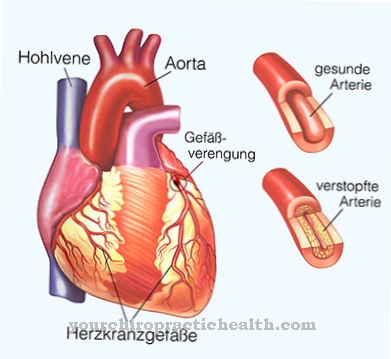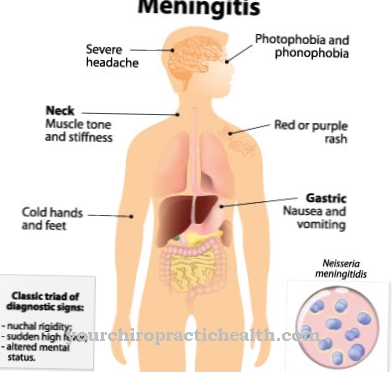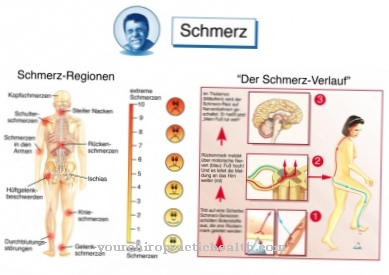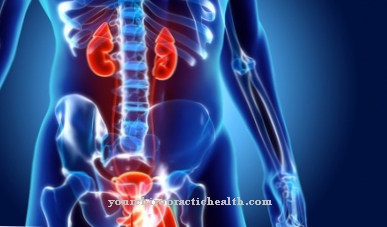A Uterine rupture is a partial or complete Tear in the wall of the uteruswhich occurs in most cases during childbirth or labor-induced. With a frequency of around 1: 1500 births, a uterine rupture is a relatively rare, albeit a very life-threatening complication due to the high mortality rate.
What is a uterine rupture?
As Uterine rupture a tear or tear in the uterine wall is usually referred to during the birth process. In principle, there is a difference between a complete tear with involvement of the serosa (smooth lining of the peritoneum cavity) and dehiscence (divergence) of all layers and an incomplete or extraperitoneal rupture, which if the serosa remains intact only affects the myometrium (layer of the uterine wall made of smooth muscles) and closes does not result in bleeding into the abdominal cavity, differentiated.
As a rule, the rupture is located at the junction between the body and the cervix (isthmus uteri), more rarely at a weak point in the wall ("silent sub-rupture"). The main symptom of a rupture of the uterus is an abrupt abdominal pain with pronounced tenderness and a sudden cessation (cessation) of labor.
As a result of the blood loss, signs of shock appear (hypotension, tachycardia, pale and cold-sweaty skin, increased clouding of consciousness). In addition, no movements of the unborn child can be detected after a uterine rupture and the heart sounds of the same are bradycardial (slowed down) or nonexistent.
causes
In principle, a Uterine rupture induced by a discrepancy between the load-bearing capacity of the uterine wall and the actual load present.
Depending on the underlying cause, a distinction is made between different types of rupture. For example, as a result of previous damage to the uterus such as enucleation of the uterine myoma (myoma enucleation), placenta detachment, metroplasty or cesarean section, a scar rupture can occur. Previous surgery on the uterus is the most common cause of rupture.
A narrow pelvis and fetal position anomalies (transverse position, mentoposterior facial position of the child, arm prolapse, macrosomia) can cause an overstretching rupture. On the other hand, a spontaneous rupture can be caused by an endometriosis or a hemangioma. Blunt or sharp abdominal trauma (e.g. as a result of a forceps extraction or a traffic accident) can also lead to a violent or traumatic uterine rupture.
Symptoms, ailments & signs
A uterine rupture announces itself with warning signals. Affected women are extremely concerned during pregnancy. You complain of severe pain in the uterus. In particular, the so-called labor storm indicates complications during childbirth. The frequency of labor increases steadily in the run-up to the birth.
If the uterus ruptures, pain is felt immediately. These expand beyond the uterus to the entire abdomen. The expectant mothers often describe the feeling of being torn from the inside. As a result of the injury, vaginal bleeding occurs, which in turn can trigger a shock. The blood pressure is racing in the basement and the heart rate increases.
Cold sweat appears on the forehead and in seconds the skin turns a strangely pale color. In this situation the contractions stop. Women lose control of their birth and can no longer feel their child's movements. A uterine rupture affects about one in 1,500 expectant mothers. Doctors distinguish a complete and incomplete crack. If this occurs, blood will still be present in the mother's urine a short time after the birth.
Diagnosis & course
A Uterine rupture is usually diagnosed based on clinical symptoms. In addition, every unclear postpartum and intrapartum shock condition should be interpreted as a clear indication of a uterine rupture.
In addition, certain symptoms can signal an impending rupture of the uterus. For example, hyperactive, painful contractions up to thunderstorms (pathologically increased labor activity), tenderness in the lower uterine segment on external palpation, a lifting of the bandl ring above the navel, and restlessness and anxiety in the pregnant woman as a result of the pronounced pain indicate an impending uterine rupture.
However, in many cases a partial rupture of the uterus can also be asymptomatic. With a mortality rate of 10 percent in the affected mothers and 50 percent in the unborn fetuses, a uterine rupture is one of the most serious and life-threatening obstetric complications and should always be treated immediately by emergency medical care.
Complications
Depending on the size of the tear, a uterine rupture can have serious complications. Most often, a ruptured uterus causes profuse vaginal bleeding, which can lead to anemia. Severe abdominal pain and sweating are some of the possible accompanying symptoms.
A pronounced rupture can lead to circulatory shock, combined with a racing heart, drop in blood pressure and other symptoms. Life-threatening complications occur if the uterine tear is not treated immediately by intensive care. Then there is a risk that the affected woman will bleed to death or have a heart attack.
A circulatory collapse can also be life threatening. A rupture of the uterus causes the heart rate to slow down in children. In many cases, the child dies of heart failure or severe circulatory shock. Other, mostly serious complications cannot be ruled out with a pronounced uterine tear.
When treating such a serious rupture, the risks come from the prescribed labor suppressants, which are associated with various side effects and interactions. Any removal of the uterus can result in injuries and infections. After the procedure, the woman's fertility is reduced and further physical and psychological problems arise. The loss of the child has far-reaching emotional consequences for the person concerned.
When should you go to the doctor?
A doctor must always be contacted if the uterus ruptures. As a rule, immediate treatment is also necessary so that there are no further complications or complaints that, in the worst case, lead to the death of the mother or child. Therefore, a medical professional must be contacted at the first symptoms or signs of this complaint. A doctor should be contacted with this complaint if the frequency of pre-birth contractions increases significantly. In most cases, the uterine rupture causes severe pain.
There is also bleeding in the vaginal area, which is also associated with severe abdominal pain. Low blood pressure can also indicate the uterine rupture and should be checked by a doctor. Bloody urine can also indicate this complaint. In most cases, the uterine rupture will be treated by a doctor right after birth. Whether this will lead to further complications or to reduced life expectancy for the mother or child cannot generally be predicted.
Treatment & Therapy
Both a threatening and an occurred Uterine rupture immediate emergency medical measures are indicated. In order to inhibit labor, so-called tocolytics, which minimize the contraction activity of the uterus, are infused intravenously as part of acute tocolysis.
As standard, an intravenous bolus injection with 0.025 mg fenoterol (a beta-2 sympathomimetic) is the drug of first choice, which can be repeated once without risking circulatory decompensation of the unborn child. In addition, shock prophylactic measures are required.
If a rupture is suspected, immediate admission to a clinic is indicated, where, as a rule, a laparatomy (surgical opening of the abdominal wall) or, if contractions are present, a caesarean section (caesarean section, caesarean section) as soon as possible if the uterus is in contractions ) with subsequent reconstruction of the uterus.
If the bleeding cannot be stopped or if it is particularly pronounced, a total laparoscopic hysterectomy or uterine extirpation (removal of the uterus) may be necessary. If a rupture of the uterus is suspected during the delivery process, an emergency caesarean section is also performed.At the same time, the hypovolemic shock (reduced circulating flowering) due to the loss of blood in the event of a uterine rupture should always be treated with volume and blood administration.
prevention
One Uterine rupture cannot be prevented in every case. If surgical interventions have already been carried out on the uterus, the risk of a rupture, especially scar rupture, is slightly increased and the course of pregnancy should be monitored and controlled accordingly due to the high mortality associated with uterine ruptures.
Aftercare
As part of the medical follow-up in the event of a ruptured uterus, the affected woman and, if applicable, the unborn child must be considered. It is also relevant whether organs adjacent to the uterus are also affected. Medical follow-up care in the event of a uterine rupture is based on how well the tear could be surgically controlled and what damage the bleeding has left on the mother (and child).
For the woman affected by the uterine rupture, the main focus is on stabilizing the body. It is not uncommon for a uterine tear to be accompanied by shock-like symptoms, which makes observation and a follow-up examination necessary.
Furthermore, wound care and, if necessary, drugs to control bleeding are indicated as follow-up care. If a caesarean section was performed due to the rupture, the child must be examined carefully. A rupture of the uterus puts the child at risk in the abdomen and, among other things, causes the heart rate to drop. Any consequential damage must be identified accordingly.
If a hysterectomy was performed to treat the rupture of the uterus, follow-up care for those affected does not only consist of check-ups, but also, if necessary, of psychological support. In the case of a covered uterine tear, which does not lead to bleeding into the abdominal cavity, medical follow-up care is often not necessary. An observation of the tissue, especially during a possible further pregnancy, is sufficient.
You can do that yourself
If this birth complication was announced in advance or if there were risk factors, the expectant mothers were closely looked after by their doctors or in the clinics. If, on the other hand, the prospective mothers are surprised by the symptoms of a uterine rupture shortly before giving birth, it is important to act quickly. If the patient is already in the clinic, she needs intensive medical care. If she is not yet in the clinic, she must be transported there quickly, as there is a mortal danger to both the mother and the unborn child.
The uterine rupture is treated surgically. Regardless of how the situation turned out, it is very stressful for the patient concerned. Either because she and her unborn child were in mortal danger, or because she even lost her child and may not be able to become a mother in the future either. In order to cope with this situation, she is advised to undergo psychotherapeutic follow-up treatment. Joining a self-help group can also be helpful. For example, the website Schmetterlingkinder.de offers immediate help in the event of a lost child. The pages Elternforen.com or Familienplanung.de also provide helpful information under the term uterine rupture.
The bleeding that occurred when the uterus ruptured may also have caused an iron deficiency. Therefore, the patient should have her iron status monitored and, if necessary, take iron supplements regularly.













.jpg)

.jpg)
.jpg)











.jpg)